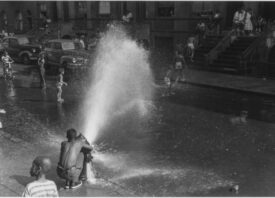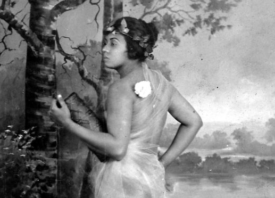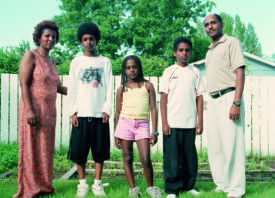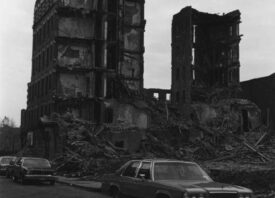Search this site
Dawoud Bey’s Powerful Portrait of Black America Over Half a Century



On January 18, 1969, during the height of the Black Arts Movement in America, Thomas P.F. Hoving, then Director of the Metropolitan Museum of Art and curator Allon Schoener mounted Harlem on My Mind: Cultural Capital of Black America, 1900-1968, a three month long multimedia exhibition designed extensively to highlight the history of Harlem throughout the twentieth century.
But, like so many Americans whose privilege enables them to effortlessly ignore the issue of race, the exhibition largely excluded the work of Black painters and sculptors living and working in Harlem. In response, the Black Emergency Cultural Coalition, a group of 75 African American artists including Romare Bearden and Norman Lewis, came together to picket in front of the museum in protest of the show — drawing so much attention to the cause that African American artists finally started receiving their due by the white-owned institution.
The protests raised awareness and the public turned out, some 75,000 in the opening week, with hundreds of thousands more during its run. Among those who came to see the work was Dawoud Bey, then a 16 year old high school student hailing from Queens, who wanted to see the protests. But things were quiet that day so he headed inside to see the show and was taken with the photographs of James Van Der Zee, one of the few Black photographers to have his own studio in the first half of the twentieth century. Van Der Zee’s records of the Harlem Renaissance were both art and artifact, evidence of a people and a culture that white America knew virtually nothing about.

Van Der Zee’s work impressed upon Bey the power of photography to not only define the times in which they were made but to transcend them as a portal bridging present and past. Bey then began to seriously think about becoming a photographer. In 1975, Bey embarked on his first major body of work, Harlem USA, a series of black and white street photographs and portraits made documenting the community during the mid-late 1970s. He debuted the work in 1979 at the Studio Museum in Harlem, showing just 25 images from a seminal series, finally showing it in full in 2012 at the Art Institute of Chicago.
In the intervening decades, Bey has amassed a majestic oeuvre that weaves together a wide array of styles, techniques, and genres into a glorious tapestry that captures the breathtaking depth, intricate nuances and limitless complexities of Black life in America over the past half century. In Two American Projects, the new book from Yale University Press designed to accompany a major touring museum exhibition of the same name now on hold due to COVID-19, Bey charts a new map of the past, using photography as a means to explore histories told and untold in a new light.

In 2012 series, The Birmingham Project, Bey revisits the tragic events of September 15, 1963, when four members of the Ku Klux Klan, including Thomas Edwin Blanton Jr. and Bobby Cherry, bombed the 16th Street Baptist Church, killing six children. “They did not die in vain,” Dr. King told a group of 3,300 mourners who gathered to attend the funeral for three of the girls. “God still has a way of bringing good out of evil.” It is just this truth that Bey explores in his series of 16 diptychs pairing children the same age as those who were slain with adults 50 years their senior, to mark the passage of half a century.
The portraits were made in the Birmingham Museum of Art and the Bethel Baptists Church, both sites tied to the violence that plagued the city known during the Civil Rights Movement as “Bombingham.” During Jim Crow, African Americans were only allowed to visit the museum once a week, while the church had been bombed three times, as had the home of its former pastor, the Reverend Fred L. Shuttlesworth.
“The project asks that we consider the past through the present moment,” Bey has said of the work, a telling reminder that history is not a one-time event but rather a series of cause and effects that spread far beyond their initial event, like ripples in a pond when a foreign object upsets its innate calm. The children who died in 1963 are far from the first or the last to be violently torn from their families by the terrorist spectacle of white nationalism. While we say their names now — Tamir Rice, Trayvon Martin, Michael Brown — so many others have perished without headlines, the trauma of their destruction etched in their familiies’ bloodlines.


But survival, above all things, is paramount. Bey’s portraits made over the years is a testament to this, as is the series Night Coming Tenderly, Black — a series that we had the great honor of interviewing Bey for in 2019 when he first showed this work. Here, Bey retraces the Underground Railroad in a series of black-on-black masterpieces that stand as silent testaments to the beauty and hope, pain and horror, strength and courage of Black men and women fleeing slavery in the South.
“The photographs are meant to evoke the feeling of what it might have both looked and felt like for those fugitive black bodies moving through the Ohio landscape. I want the vantage point of the photographs to suggest what they might have seen, and what that landscape might have felt like; to cling closely to the side of a house that is an Underground Railroad ‘station’ so as not to be fully exposed, and to have to negotiate the shifting and sometimes difficult terrain,” Bey said.
“I would hope that viewers might be inextricably drawn to experience the photographs through a lens of the past, even though they are clearly made in the contemporary moment, and that the landscape may come alive and be viewed as an experience that is framed by the past, even as they know the work is made in the present. I want put the viewer in a kind of liminal space somewhere between past and present.”





All images: Dawoud Bey
Further reading: Photographers Celebrate Black History, from the 1920s to Now



